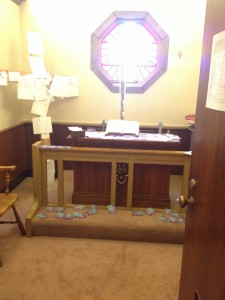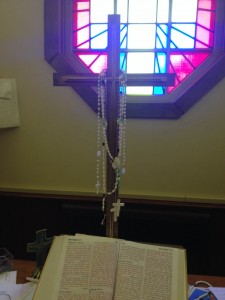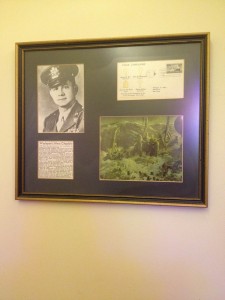Monthly Archives: August 2014
Research files: The Meditation Room
Illinois Wesleyan University’s Meditation Room
Guest posted by Melissa Mariotti
Not much is known about Illinois Wesleyan’s Meditation Room; in fact many people are unaware of its existence. The purpose of this room is all in the name; a place for quiet reflection and meditation. It is located on the second floor of the Memorial Center, up the stairs from the Davidson room.It is a small space filled with six chairs, an altar, several crosses (both big and small), a prayer kneeler, paper and note cards for writing notes and prayers, several Bibles, rosaries, and a large plaque dedicated to the Wesleyan students who died in combat during World War II. It is interesting to note that the Meditation Room was not part of the original plans for the Memorial Center. While the building was constructed in 1947, the Meditation Room was not added until about 10 years later during the 1957-1958 school year after students began requesting a space for quiet meditation. It is well-known that Illinois Wesleyan began as a Methodist institution, so it is somewhat surprising to see that students requested a non-denominational meditation room. It may have begun as nondenominational, but it is clear that after time that its purpose has shifted from a small war memorial to a small church. Many people have found a sanctuary in this room. On the door there is a sign-in sheet where you can see how often the room gets used. People, both students and alumni, have written notes on it, saying how thankful they were for the space.
It is unclear as to when most of the items in the room were added or by whom. The earliest evidence Wesleyan has is a photo taken during the 1960s of the altar and a cross. According to a 1954 Argus article, the room was “furnished by the Lee McClure family.” At that time, there was only the altar, a cross, and the chairs. As for the rest of the items, such as the large crosses, it is uncertain. There are six chairs placed against both sides of the room that were donated by Mr. and Mrs. Lee McClure in honor of their son, Bruce McClure, a student at Wesleyan, who died in combat in 1945.
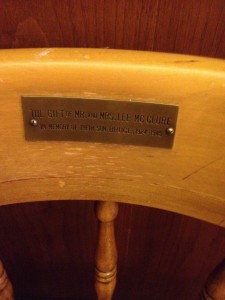
“The Gift of Mr. and Mrs. Lee McClure, in Memory of their Son, Bruce, 1924-1945.” Photo Taken by Melissa Mariotti
Each chair has a small plaque on them to commemorate him. Bruce came to Wesleyan in 1942 and was enlisted that following spring. He was a member of Phi Gamma Delta.
It is uncertain whether or not every item in the room was donated by the McClure family
There is a large plaque that is placed on the wall with the names of the students who fought and died in combat. The plaque is titled, “Illinois Wesleyan University Students Who Made the Supreme Sacrifice in World War Two.”
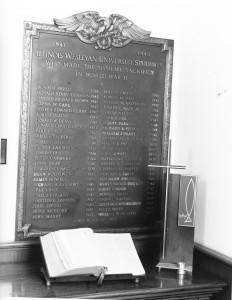
Plaque commemorating the students from IWU who gave their lives during WWII. Photo found in RG 18-1/17
Among those names is George Lansing Fox, whom the room is now dedicated to. There is small collage dedicated to him and “The Four Chaplains.” George L. Fox graduated from Illinois Wesleyan in 1932 and served in World War I, receiving many prestigious awards, such as the Silver Star, Purple Heart, the Croix de Guerre, and the Furaguerre. He enlisted in World War II as a chaplain and deployed on a ship called the USS Dorchester.
In 1943 the USS Dorchester was torpedoed by a German submarine. Fox was one of four chaplains on the ship. The others were Catholic, Protestant, and Jewish. After realizing that there were not enough life vests on the ship, the four chaplains gave up their own so others could survive. They were last seen kneeling on the deck of the ship in prayer as it sank.In 1951 president Truman dedicated a chapel at Temple University, Pennsylvania, The Chapel of the Four Chaplains, and made a commemorative postage stamp in their honor.








